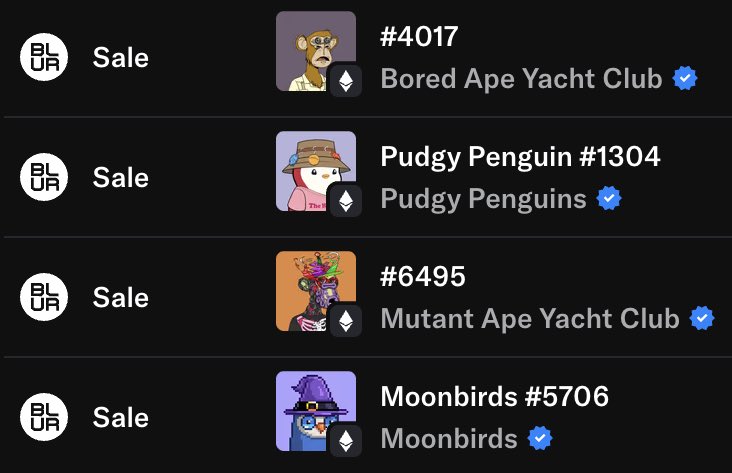Blur fiyatı


Blur Hakkında
Blur fiyat performansı
Sosyal medyada Blur






Kılavuzlar

Ücretsiz bir OKX TR hesabı oluşturun
Hesabınıza varlık yatırın.
Kriptonuzu seçin.
Blur Hakkında SSS
Ekim 2022’de tanıtılan Blur, yüksek ücretler ve yetersiz telif hakkı yapıları gibi temel zorlukları ele alan sıfır ücretli bir NFT pazarıdır. Sezgisel kullanıcı arayüzü ile Blur, hızlı NFT taramalarını kolaylaştırır ve gelişmiş kullanıcı deneyimi için yenilikçi bir sıralama sistemi kullanır.
Blur’un teşvik modeli, çok sayıda NFT tüccarını ekosistemine katılmaya başarıyla ikna etti. Platform, alıcılar için zorlayıcı bir teşvik sağlıyor: telif ücretini ne kadar artırırlarsa, gelecekteki airdrop’ları alma şansları o kadar artıyor.
Sonuç olarak, alıcılar telif ücretlerini yükseltmek için motive oluyor ve bu da hem alıcılar hem de içerik oluşturucular için karşılıklı fayda sağlıyor. Bu yenilikçi yaklaşım olumlu bir geri bildirim döngüsü yaratarak katılımı artırıyor ve Blur içinde gelişen bir ekosistemi teşvik ediyor.
OKX TR kripto para platformunda BLUR tokenlerini kolayca satın alın. OKX TR’nin spot ticaret terminali BLUR/USDT ticaret çiftini içerir.
Ayrıca OKX TR Convert kullanarak XRP (XRP), Cardano (ADA), Solana (SOL), ve Chainlink (LINK) dahil olmak üzere mevcut kripto paralarınızı sıfır ücretle ve fiyat farkı olmadan BLUR ile takas edebilirsiniz.
Blur varlığına daha yakından bakın
Değiştirilemez tokenler (NFT), kullanım alanları genişlemeye devam ettikçe giderek daha popüler hale gelmiştir. Bununla birlikte, NFT yaratıcıları ve toplayıcıları yüksek pazar yeri ücretleri, eşit olmayan telif ücretleri, yavaş süpürme ve düşük işlem hacmi gibi sorunlarla karşılaşmaktadır.
Bu sorunları çözmeye yardımcı olmak için Blur (BLUR) gibi platformlar NFT alanında devrim yaratmak için ortaya çıktı. Lansmanından sonraki birkaç ay içinde, koleksiyoncular ve içerik oluşturucular tarafından sevilen lider bir NFT pazaryeri haline geldi.
Blur nedir
Blur, Ethereum blok zinciri üzerine inşa edilmiş bir NFT pazarı ve veri toplayıcısıdır. Daha hızlı bir süpürme oranı, sıfır piyasa ücreti ve ticaret faaliyetleri için teşvikler de dahil olmak üzere, onu yaratıcılar ve koleksiyoncular için daha çekici bir NFT pazarı haline getiren çeşitli özelliklere sahiptir. İçerik oluşturucular ayrıca daha iyi bir telif ücreti yapısı, yüksek işlem hacmi ve daha küçük NFT projeleri için destek elde ediyor.
Blur nispeten yeni bir NFT pazarı olmasına rağmen, çok kısa sürede büyük ilgi gördü ve hacim bakımından en büyük NFT pazarı olan OpenSea ile rekabet etti. Bu başarının bir kısmı, Blur’un birinci sınıf yatırımcılardan ve NFT tüccarlarından 14 milyon dolar bağış toplamasına bağlanabilir.
Blur ekibi
Kurucu ekip üyelerinin tam isimleri bilinmemektedir. Ancak, takma adları ve kripto ve blok zinciri alanındaki geçmişleri bilinmektedir.
Yetenekli bir Web3 geliştiricisi olan Pacman, sadece Blur’un kurucusu değil, aynı zamanda gelişiminde de önemli bir rol oynamaktadır. Blur Vakfı’nın başında ise Direktör pozisyonunda olan Zeneca bulunuyor.
Pacman, Zeneca ve Blur ekibinin geri kalanı birlikte MIT, Five Rings Capital, Twitch, Square ve Y Combinator gibi prestijli kuruluşlarla işbirliği yaparak bu alandaki uzmanlıklarını ve deneyimlerini sergilediler.
Blur nasıl çalışır?
Ethereum blok zinciri üzerine inşa edilen ticaret platformu, birden fazla kaynaktan NFT verilerini toplar ve kullanıcılara gerçek zamanlı bilgiler görüntüler. Blur platformunda, NFT toplayıcıları trend NFT’leri, en son taban fiyatlarını, farklı projeler için işlem hacimlerini ve diğer ilgili verileri belirleyebilir.
Blur sıfır işlem ücreti hizmeti sunar, yani hem alıcılardan hem de satıcılardan işlem ücreti alınmaz. Blur ilk ortaya çıktığında, bu onların en büyük satış noktasıydı. Blur’un en büyük rakibi olan OpenSea, buna karşılık olarak ücretlerini kaldırmak zorunda kaldı. Blur ayrıca, yaratıcıların kendi tazminat yüzdelerini seçmelerine olanak tanıyan özelleştirilebilir telif paketleri de sunuyor.
Blur’un borç verme platformu
Çabalarını bir adım öteye taşıyan Blur, NFT’ler için özel olarak tasarlanmış bir kredi platformu geliştirerek tekliflerini genişletti. Bu yenilikçi özellik, NFT sahiplerine varlıklarının değerinden yararlanmak için daha fazla fırsat sağladı.
Kullanıcılar, NFT’lerini teminat göstererek, doğrudan platform üzerinden kripto para birimi cinsinden kredi alma olanağına kavuştu. Bu yeni yaklaşım, NFT sahiplerinin likiditeye erişmeleri ve dijital varlıklarının potansiyel değerini ortaya çıkarmaları için yeni yollar yarattı.
BLUR tokenomikleri
BLUR bir ERC-20 tokenidir. Şu anda dolaşımda 464 milyondan fazla BLUR tokeni bulunmaktadır ve toplam 3 milyar arzının geri kalanı emisyon için planlanacaktır. Protokol, blok doğrulama için Hisse İspatı (PoS) mutabakat mekanizmasını kullanır.
BLUR kullanım alanları
BLUR tokeni, ekosistemi içinde çeşitli amaçlara hizmet eder. Örneğin, kullanıcıların karar alma süreçlerine katılmalarını ve Blur ekosisteminin yönünü şekillendirmelerini sağlayan bir yönetişim tokeni olarak çalışır.
BLUR ayrıca, token airdrop’ları aracılığıyla kullanıcılarını ödüllendirmek için kullanılır ve kullanıcılara ekosisteme katılımları ve katılımları için teşvikler ve avantajlar sağlar. Son olarak BLUR, NFT pazarında bir para birimi olarak hareket eder, işlemleri kolaylaştırır ve dijital varlıkların satın alınması, satılması ve ticareti için bir değişim aracı olarak hizmet eder.
BLUR dağıtımı
Blur token aşağıdaki şekilde dağıtılır.
- Yüzde 40’ı airdroplar aracılığıyla erken kullanıcılara ve yaratıcılara tahsis edildi
- Yüzde 20’si ekibe ve danışmanlara verildi
- Yüzde 20’si gelecekteki gelişim için ayrılmıştır
- Yüzde 10 Likit amaçlar için
- Yüzde 10 Pazarlama ve ortaklıklar için
Blur’un gelecekteki genişleme planı
Etkileyici işlem hacmiyle Blur, sektördeki en iyi NFT pazaryeri olarak ortaya çıktı. Şubat ayında NFT işlem hacminde OpenSea’yi geçerek önemli bir kilometre taşına ulaştı ve o zamandan beri lider konumunu korudu. Blur ekibi bu konumunu uzun süre sürdürmeye kararlı.
Blur işlem hacminde üstün olsa da, OpenSea’nin hala daha fazla sayıda bireysel yatırımcıya sahip olduğunu belirtmek gerekir. Bunun ışığında Blur, daha fazla sayıda kullanıcıyı platformuna çekmek amacıyla önümüzdeki aylarda kullanıcı tabanını genişletmeyi hedefliyor.
Sorumluluk Reddi
OKX TR yatırım veya varlık tavsiyesinde bulunmaz. Dijital varlıklarla al-sat yapmanın veya bu varlıklara sahip olmanın sizin için uygun olup olmadığını, kendi finansal durumunuz çerçevesinde dikkatlice değerlendirmeniz gereklidir. Kişisel durumunuza veya koşullarınıza ilişkin sorularınız için lütfen kendi hukuk, vergi veya yatırım uzmanınıza danışın. Daha fazla ayrıntı için lütfen Kullanım Şartları ve Risk Uyarısı belgelerimize bakın. Üçüncü taraf web sitesini ("TPW") kullanarak, TPW kullanımınızın TPW koşullarına tabi olacağını ve bu koşullar uyarınca yönetileceğini kabul etmiş olursunuz. Yazılı olarak açıkça belirtilmedikçe, OKX TR ve iş ortakları ("OKX TR"), üçüncü taraf web sitesinin sahibiyle veya işleticisiyle hiçbir şekilde ilişkili değildir. Üçüncü taraf web sitesini kullanmanızdan doğabilecek her türlü zarar, hasar veya başka herhangi bir sonuçtan OKX TR'nin sorumlu ya da yükümlü olmadığını kabul ediyorsunuz. Üçüncü taraf web sitesini kullanmanın varlıklarınızdan zarar etmenize veya varlıklarınızın azalmasına yol açabileceğini lütfen unutmayın. Ürün, tüm yargı bölgelerinde mevcut olmayabilir.





